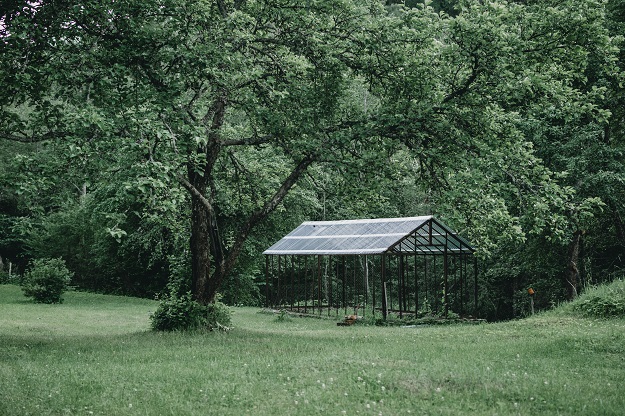The first thing a prospective owner needs to identify is what type of greenhouse structure they want. A greenhouse is for plants that need a different environment than what is outside. The plants you grow affect the design and equipment you need. This is especially true for warm weather tropical plants. A garden room or sunroom combines a gardening greenhouse and incidental living space (spa enclosure, sitting area, etc). A solarium is designed for primary living space, usually an addition to your house.

Location
Questions you should be asking are: How would a greenhouse best fit with the landscape? What is its exposure to sun, wind and weather? Is it convenient to get to? Generally a southeasterly exposure is best, with east, south and west exposures following in order. You should also consider whether the greenhouse should be free-standing or attached to your house, garage or shed. Attached structures can either be a lean-to or a freestanding greenhouse attached at one end. With attached greenhouses, issues such as the available height of the attachment wall, snow avalanching off the roof onto the greenhouse, icicles, etc. need to be considered. Attached units frequently have building code issues as well.
Size
Select a greenhouse as large as your site and budget allow because once they get started, greenhouse gardeners usually wish they had more space. The first consideration for size is the area of the greenhouse, but adequate height is also important, both for your comfort as well as providing room for tall and hanging plants. Greenhouse structures that are less than 150 square feet many times do not require a building permit, especially if they are free standing, but check out your local building codes just to be safe.
Framing Materials
Possible greenhouse framing materials include wood, aluminum & plastic. Plastic frames are generally used for short-term, temporary greenhouses. Aluminum is a more durable option if it is properly finished but is not an environmentally friendly choice. It is also more difficult to work with. Wood is a renewable resource, especially when grown using sustainable harvest techniques. It has a natural beauty that fits well with residential architecture. Clear Heart Redwood is naturally resistant to deterioration (lesser grades of redwood and some cedars are not as resistant). Wood can be left natural or stained to match your home (I recommend a stain or clear oil to preserve the wood’s beauty). When it comes to energy efficiency, framing and door materials are very important. Wood is warmer and more heat efficient than aluminum (1400 times better). Finally, wood allows easy addition of accessories such as shelves, hooks, hanging bars, and light fixtures.
Glazing Materials
Glazing can be glass or plastic products. Glass is strong, economical, attractive, clear, and long lasting. If there is a high risk of breakage (due to large hail or tree branches) or when safety glazing is required, tempered glass or twin-wall polycarbonate can be used. Twin wall is an energy efficient product but is not clear. I don’t generally recommend it for walls because its lack of transparency can make a greenhouse feel small and it is not as aesthetically pleasing.
Controlling the Greenhouse Environment
The purpose of a greenhouse is to create a different environment than what you naturally have outside. Each gardener’s environment is different, and the plants they grow vary, so each individual’s needs are slightly different. There are 5 basic environmental factors that should be considered: ventilation, heat, circulation, shade and humidity.
Ventilation
The most natural and effective way to ventilate a greenhouse is through the use of vents. They should be located in the base wall, to pull in cool air and also located in the roof to exhaust the hot air. Top opening roof vents provide natural, gentle, and quiet ventilation. When roof vents are combined with base wall vents and/or Jalousie (louvered) windows, cool air flows in low and hot air exits through the roof, helping preserve the humidity that plants love. Fan venting systems can move air effectively but can dehumidify the greenhouse during dry weather, plus they are noisy. Roof vents can be automated (using solar power) for easy operation.
Heat
Either Gas (natural or LP) or electric (120V or 240V) heaters can be used. The size of heater that you need depends on the type and size of the greenhouse, as well as the desired inside temperature and outside conditions involved. To make heating more effective, base walls can be insulated and a twin wall product or second layer of glazing can be added.
Air Circulation
Air movement is essential for a healthy greenhouse environment, reducing heating costs and condensation. I recommend gentle air movement, such as that provided by a wall mounted oscillating fan, running around the clock. This is especially important in the winter when humidity is high and conditions are ripe for mold and mildew.
Shade
Ways to shade a greenhouse include shade cloth, shading paint, roll-up shades, etc. An attractive method for shading is custom-fit shade cloth panels for all or part of the greenhouse. When it is attached to the outside of the greenhouse during the hot months, shade cloth is effective, neat in appearance, economical and reusable. Shade cloth can be attached to the inside of the greenhouse but outside panels are more effective at keeping the heat out.
Humidity
Wetting down a porous floor (such as bricks on sand or gravel) periodically is the usual method for creating humidity. An automatic humidifier or a misting/fogging system may also be used. During hot summer conditions the combination of shade, ventilation and humidity is key for your plants.
Design
How your greenhouse should be designed depends on how you plan to use it. Is it going to be a temporary, springtime shelter designed for starting a few flats of seeds, or is it going to be a year-round, permanent structure? Is it going to be tucked away in a back corner of your landscape or a prominent feature? A year-round greenhouse must be designed to handle a harsh environment both inside and out. The frame should be a durable material. Joints and other points of attachment should be solid and weather tight. To maximize light in the greenhouse the structural members should be as small as possible. A greenhouse full of plants will have condensation. A smooth inside roof surface (as opposed to corrugated materials) and sufficient roof pitch will help prevent water dripping onto you and your plants. Adequate height should be part of the greenhouse design, not only for hanging plants but your comfort as well.
Foundation
A firmly anchored, level and straight foundation can keep the greenhouse structure where it belongs. Generally, a 6” perimeter foundation, approximately 4” above grade, with a depth below frost level will suffice. While some more temporary structures don’t really need a foundation, if they aren’t anchored to the ground, they might be upset by a strong wind.
Dealing with Building Codes
Local codes and code interpretations vary greatly between areas, and even within offices, so it is the responsibility of the buyer to ensure compliance. Usually, a freestanding greenhouse smaller than 120 sq ft (and in many communities the size is going up to 200 sq ft) does not need a permit. For larger units, and attached structures, should you choose to obtain a permit, get it before your greenhouse is manufactured in case there are extra requirements that need to be met like bracing or safety glazing.
Rick Warner was the owner and president of a residential greenhouse manufacturing company for over 30 years.
Related Articles & Free Email Newsletter
Greenhouse Gardening for Beginners
Inexpensive Tools and Materials Every Small Greenhouse Grower Should Have




Comment here